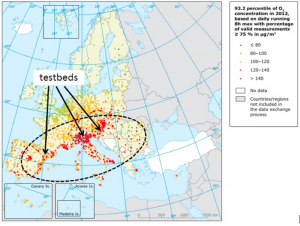 Currently in most developed countries air pollution is monitored by networks of stations equipped with high-level reference instrumentation. These monitoring stations have high costs both in terms of purchasing and maintenance, and as a result, current air quality monitoring networks have a relatively low spatial density. In CAPTOR we will therefore set up a network of low-cost sensors, maintained by European Citizens.
Currently in most developed countries air pollution is monitored by networks of stations equipped with high-level reference instrumentation. These monitoring stations have high costs both in terms of purchasing and maintenance, and as a result, current air quality monitoring networks have a relatively low spatial density. In CAPTOR we will therefore set up a network of low-cost sensors, maintained by European Citizens.
We will implement and test this low-cost sensor network for measuring Ozone pollution in three selected regions heavily affected by Ozone pollution:
- Spain: Barcelonès, Maresme, Vallès or Baix Ripolles
- Italy: Piemonte region, Lombardia region, Veneto region and Emilia Romagna region
- Austria: Niederösterreich, Burgenland, Steiermark
Become a sensor host and measure the ozone level around your house
It’s very easy, in CAPTOR sensor hosts don’t need previous experience or training. Sensor hosts are asked to provide place for a sensor for 3 periods of measurement in Spain (summer of 2016, 2017 and 2018) and two periods of measurement in Austria and Italy (summer 2017 and 2018) . Sensors are provided by the project and also installed and uninstall by project members.
The citizens’ sensors will collect data for tropospheric ozone, which are key to improve scientific and citizen knowledge about the problem, as well as to mobilize citizens and local decision makers to find solutions. The data will be public and the project will inform sensor hosts about the quality of the air and the proposals to change the situation in an understandable manner.
Why should you become a sensor host?
- As sensor host you know if you breathe polluted air.
- You raise awareness for the effects of ozone pollution on health, crops and nature.
- You collaborate with scientists and support finding solutions to the ozone problem.
- You support stimulating discussions about air pollution in your local region.
- If volunteers wish, they are mentioned in project results as well as the planned dissemination through e.g. newsletters, highlighting their key contribution to the project. The volunteers who wish so will be able to give their testimony in order to expand the impact of the project, by e.g. contributing a statement in an newspaper article or for a project video.
What are the requirements to be a sensor host?
- It is easy, you do not need any previous experience or trainings.
- Sensor hosts live in the study area (see above).
- Live in a rural area (away from the direct influence of traffic roads or industries, near woods or fields, but not to the top of high mountains)
- Have a place where to install the sensor:
- on the outside, on a balcony or on a window sill
- located between 1.5 and 4 meters above the ground,
- no air conditioning or heater output near,
- no structures close to the place which hinder the movement of the air,
- with electric connection (a normal connection for power supply for domestic use).
- Does not imply any cost, only the electricity which we estimate in a total of 1.5 euros a year (the sensor consumption is very low)
What to do next?

